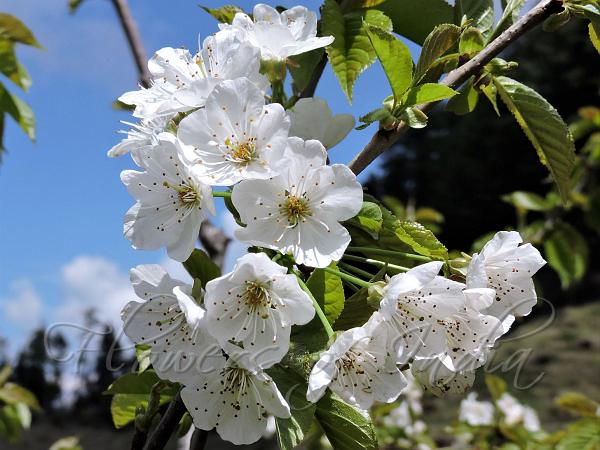|
| Sweet Cherry |
|

|

|
|
|
|
Photo: |
Botanical name: Prunus avium Family: Rosaceae (Rose family)
Synonyms: Cerasus avium, Prunus juliana, Prunus varia
Synonyms: Cerasus avium, Prunus juliana, Prunus varia
Sweet Cherry is a deciduous tree growing to 15-32 m
tall, with a trunk up to 5 ft in diameter. Young trees show strong
apical dominance with a straight trunk and symmetrical conical crown,
becoming rounded to irregular on old trees. The bark is smooth
purplish-brown with prominent horizontal grey-brown lenticels on young
trees, becoming thick dark blackish-brown and fissured on old trees.
The leaves are alternate, simple ovoid-pointed, 7-14 cm long and 4-7 cm
broad, hairless matt or somewhat shiny green above, variably finely
downy beneath, with a sawtoothed margin and a tapering tip, with a
green or reddish leaf-stalk 2-3.5 cm long bearing two to five small red
glands. The tip of each sawtoothedd edge of the leaves also bear small
red glands. Flowers are produced in early spring at the same time as
the new leaves, borne in corymbs of two to six together, each flower
pendent on a 2-5 cm flower-cluster-stalk, 2.5-3.5 cm in diameter, with
five pure white petals, yellowish stamens, and a superior ovary; they
are hermaphroditic, and pollinated by bees. The ovary contains two
ovules, only one of which becomes the seed. The fruit is a drupe 1-2 cm
in diameter, bright red to dark purple when mature in midsummer. The
fruit are readily eaten by numerous kinds of birds and mammals. Some
rodents, and a few birds also crack open the stones to eat the kernel
inside. Sweet Cherry is native to Europe to West Asia till Afghanistan.
| Identification credit: Anil Thakur | Photographed in Shimla, Himachal Pradesh & Kashmir. |
• Is this flower misidentified? If yes,